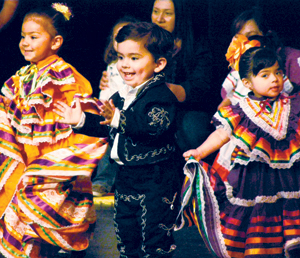Features & Columns
Phoenix Plaza
 SMALL IS BEAUTIFUL: The peewee class of Los Lupe-os de San Jose showed off its steps at a performance at the Mexican Heritage Theater.Photograph by Julian Peeples
SMALL IS BEAUTIFUL: The peewee class of Los Lupe-os de San Jose showed off its steps at a performance at the Mexican Heritage Theater.Photograph by Julian Peeples
EVERYTHING goes in cycles, and now it looks like the beleaguered Mexican Heritage Plaza (MHP) will soon enter a new chapter in its evolution. Since children under the age of 9 comprise 19 percent of the surrounding neighborhood population, an elaborate business plan for "The School of Arts and Culture at MHP" has now emerged.
Partly orchestrated by 1stACT Silicon Valley and with private seed funding in place pending the city of San Jose's approval, the business plan includes a 12-18 month marketing scheme, an "interim incubator-operator" position, several fundraising strategies, implementations for management, facilities, technology, capital replacement and even an exit strategy for the seed donors once their support is no longer needed. The plan also outlines how to reduce dependency gradually on the city for financial assistance. Pending the city's approval, a pilot program will soon launch to test all these ideas.
After taking over operations of the plaza from Mexican Heritage Corporation in 2008, the San Jose City Council directed its staff to assemble a community steering committee to study and reinvent the long-term, programmatic mission of the plaza, including a sustainable funding and governance model.
Following several meetings between July 2009 and April 2010, the 13-member committee approved a new vision for the property as a community school of arts and culture. After the city's unanimous vote one month later, the committee began "Phase II," that is, writing the business plan, doing the community outreach, marketing research and visiting sites of similar institutions.
Connie Martinez and Tamara Alvarado of 1stACT Silicon Valley—two of the plan's primary authors—spoke to the City Council's Community and Economic Development Committee a few weeks ago, emphasizing that the business plan includes "eventually developing a Latino leadership program of local folks, not some high-floating people from out of town." But they added that the cultural offerings of the MHP will not be limited to just the Mexican-American community.
Alvarado told me that potential funders from the private sector, including Adobe and the Shortino Family Foundation, are gung-ho on the idea of supporting youth programs. The youth component is what brought them on board as potential donors.
"We, as an arts community, need to show that we value kids," she said. "Establishing a school of arts and culture at the plaza is the best and highest use of the facility."
The business plan says, "One thing that everyone in Silicon Valley cares about regardless of sector, ethnicity, geography, gender or age is our children." The plan's authors believe this idea "has the right mix of relevant arts and cultural offerings, community support, entrepreneurial spirit and a mortgage-free facility serving low-income children and families to attract philanthropic support." Amen. I hope they offer creative-writing classes for the kids as well.
I remember when the plaza first opened, in 1999. The theater was the most high-tech venue of its kind in the South Bay. The sound-reinforcement system alone must have cost a few million. The MHP looked gorgeous on the inside, but from outside it appeared fortresslike and cut off from the neighborhood. It didn't look welcoming.
Many observers questioned its vision, direction and target audience. Was it a place for the community to take part in affordable activities or was it a venue for high rollers to drop $150 for a concert? The powers-that-be didn't seem to have any answers. It appeared that no one was really in charge, giving the impression that the project was yet another failed Redevelopment Agency attempt to build something that resembled Disneyland, in order to do something to make San Jose look like a big city as soon as possible, but without any realistic plan of who or what was going to run the place. (If you're new in town, this is how everything in San Jose was done in those days.)
In any event, the authors of the new business plan seem to have learned from all of these mistakes. Alvarado says part of the overall plan is to reconnect the facility with the community. "We need to figure out how we can radiate outwards," she said. "That neighborhood is entrepreneurial. There are close to 500 small businesses in that area. There's a lot of strength and hustle. We want to build that up."


